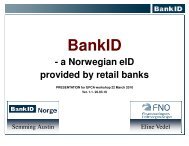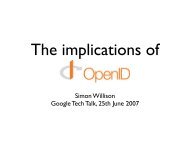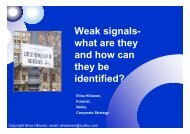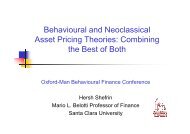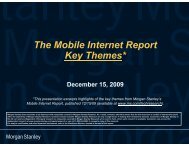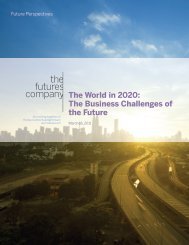From Efficient Markets Theory to Behavioral Finance
From Efficient Markets Theory to Behavioral Finance
From Efficient Markets Theory to Behavioral Finance
You also want an ePaper? Increase the reach of your titles
YUMPU automatically turns print PDFs into web optimized ePapers that Google loves.
96 Journal of Economic Perspectives<br />
against feedback. Moreover, even if feedback did imply some momentum, we can<br />
also note that the random walk character of s<strong>to</strong>ck prices is really not fully supported<br />
by the evidence anyway, and that in fact there has been more than a little momentum<br />
<strong>to</strong> s<strong>to</strong>ck prices. Jegadeesh and Titman (1993) found that winning s<strong>to</strong>cks, s<strong>to</strong>cks<br />
that showed exceptionally high six-month returns, beat losing s<strong>to</strong>cks, s<strong>to</strong>cks that<br />
showed exceptionally low six-month returns, by 12 percent over the following year.<br />
In contrast, over longer periods of time this momentum seems <strong>to</strong> reverse itself. De<br />
Bondt and Thaler (1985) find that over the period 1926 <strong>to</strong> 1982, s<strong>to</strong>cks represented<br />
on the Center for Research in Security Prices data set of the University of Chicago<br />
whose returns had been in the <strong>to</strong>p decile across firms over three years (thus,<br />
“winner” s<strong>to</strong>cks) tended <strong>to</strong> show negative cumulative returns in the succeeding<br />
three years. They also found that “loser” s<strong>to</strong>cks whose returns had been in the<br />
bot<strong>to</strong>m decile over the prior three years tended <strong>to</strong> show positive returns over the<br />
succeeding three years. Thus, there is a tendency for s<strong>to</strong>ck prices <strong>to</strong> continue in the<br />
same direction over intervals of six months <strong>to</strong> a year, but <strong>to</strong> reverse themselves over<br />
longer intervals. Campbell, Lo and Mackinlay (1996) document this fact carefully. 16<br />
A pattern like this is certainly consistent with some combination of feedback effects<br />
and other demand fac<strong>to</strong>rs driving the s<strong>to</strong>ck market largely independently of<br />
fundamentals.<br />
Smart Money vs. Ordinary Inves<strong>to</strong>rs<br />
Theoretical models of efficient financial markets that represent everyone as<br />
rational optimizers can be no more than metaphors for the world around us.<br />
Nothing could be more absurd than <strong>to</strong> claim that everyone knows how <strong>to</strong> solve<br />
complex s<strong>to</strong>chastic optimization models. For these theoretical models <strong>to</strong> have any<br />
relevance <strong>to</strong> the s<strong>to</strong>ck market, it must somehow be the case that a smaller element<br />
of “smart money” or the “marginal trader” can offset the foolishness of many<br />
inves<strong>to</strong>rs and make the markets efficient.<br />
The efficient markets theory, as it is commonly expressed, asserts that when<br />
irrational optimists buy a s<strong>to</strong>ck, smart money sells, and when irrational pessimists<br />
sell a s<strong>to</strong>ck, smart money buys, thereby eliminating the effect of the irrational<br />
traders on market price. But finance theory does not necessarily imply that smart<br />
money succeeds in fully offsetting the impact of ordinary inves<strong>to</strong>rs. In recent years,<br />
research in behavioral finance has shed some important light on the implications<br />
of the presence of these two classes of inves<strong>to</strong>rs for theory and also on some<br />
characteristics of the people in the two classes.<br />
<strong>From</strong> a theoretical point of view, it is far from clear that smart money has the<br />
power <strong>to</strong> drive market prices <strong>to</strong> fundamental values. For example, in one model<br />
with both feedback traders and smart money, the smart money tended <strong>to</strong> amplify,<br />
rather than diminish, the effect of feedback traders, by buying in ahead of the<br />
16 Grinblatt and Han (2001) have argued that this tendency of s<strong>to</strong>ck prices <strong>to</strong> show momentum for a<br />
while and then reverse themselves might be related <strong>to</strong> the phenomenon that inves<strong>to</strong>rs tend <strong>to</strong> hold on<br />
<strong>to</strong> losers and sell winners (Statman and Shefrin, 1985; Odean, 1998).



